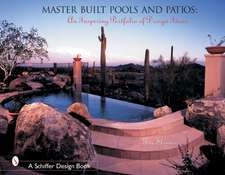Architecture of England, Scotland, and Wales: Reference Guides to National Architecture
Autor Nigel R. Jonesen Limba Engleză Hardback – 29 iun 2005 – vârsta până la 17 ani
Preț: 322.14 lei
Preț vechi: 555.79 lei
-42% Nou
Puncte Express: 483
Preț estimativ în valută:
61.65€ • 64.12$ • 51.59£
61.65€ • 64.12$ • 51.59£
Carte tipărită la comandă
Livrare economică 15-29 martie
Preluare comenzi: 021 569.72.76
Specificații
ISBN-13: 9780313318504
ISBN-10: 0313318506
Pagini: 400
Dimensiuni: 156 x 235 x 35 mm
Greutate: 0.75 kg
Editura: Bloomsbury Publishing
Colecția Greenwood
Seria Reference Guides to National Architecture
Locul publicării:New York, United States
ISBN-10: 0313318506
Pagini: 400
Dimensiuni: 156 x 235 x 35 mm
Greutate: 0.75 kg
Editura: Bloomsbury Publishing
Colecția Greenwood
Seria Reference Guides to National Architecture
Locul publicării:New York, United States
Notă biografică
Nigel R. Jones is Associate Professor of Architecture at Oklahoma State University, where he teaches design studio, perspective, and the history of Greek and Roman architecture and English Renaissance and Early American architecture, and also serves as Academic Advisor to the undergraduate Bachelor of Architecture program.
Cuprins
Entries by LocationEntries by Architectural StyleEntries by Architects, Designers, and EngineersSimplified Summary of British Architectural StylesTimeline of British ArchitecturePrefaceAcknowledgmentsIntroductionAlnwick Castle, Northumberland, EnglandBalmoral Castle, Aberdeenshire, ScotlandThe Banqueting House, Whitehall, LondonBath, Avon, EnglandBelton House, Lincolnshire, EnglandBlenheim Palace, Oxfordshire, EnglandThe British Museum, Bloomsbury, LondonBroadleys, Cumbria, EnglandBuckingham Palace, LondonCaernarfon Castle, Gwynedd, WalesCardiff Castle, Cardiff, South Glamorgan, WalesThe Cathedral Church of Christ, St. Peter's Mount and The Metropolitan Cathedral of Christ the King, Liverpool, EnglandThe Cenotaph, Whitehall, LondonCharters and the Modern Movement, Berkshire, EnglandChatsworth House, Derbyshire, EnglandChester, Cheshire, EnglandChiswick House, Chiswick, LondonThe Church of St. John the Baptist, Huntley, Gloucestershire, EnglandCoventry Cathedral, Coventry, Warwickshire, EnglandCraigievar Castle, Aberdeenshire, ScotlandThe Crystal Palace, Hyde Park, LondonDitherington Flax Mill, Shrewsbury, ShropshireThe Durham Cathedral Church of Christ and Blessed Mary the Virgin, Durham, EnglandEaton Hall, Cheshire, EnglandErddig Hall, Wrexham, WalesFonthill Abbey, Wiltshire, EnglandGlasgow School of Art, Glasgow, ScotlandHaddon Hall, Derbyshire, EnglandHadrian's Wall, Bowness-on-Solway to Wallsend-on-Tyne, near English-Scottish borderHampton Court Palace, LondonHardwick Hall, Derbyshire, EnglandHarewood House, Yorkshire, EnglandHighgrove, Tetbury, Gloucestershire, EnglandHolkham Hall, Norfolk, EnglandThe Houses of Parliament (Palace of Westminster), Westminster, LondonIronbridge, Coalbrookedale, Shropshire, EnglandKing's College Chapel, Cambridge, EnglandLittle Moreton Hall, Cheshire, EnglandLloyd's of London, LondonLondon Bridge, LondonLondon City Hall, The Queen's Walk, LondonThe "London Eye," The South Bank, LondonLutyens Country Houses, various sitesThe Millennium Bridge, LondonThe Millennium Dome, Greenwich, LondonNumber 10 Downing Street, Whitehall, LondonThe Parish Church of St. Giles, Wrexham, WalesPortmeirion, Merioneth, WalesPoundbury, Dorchester, Dorset, EnglandPublic Telephone KiosksThe Queen's House and The Royal Naval Hospital, Greenwich, LondonRed House, Bexleyheath, Kent, EnglandRegent's Park and Regent Street, LondonThe Royal Albert Hall, South Kensington, LondonThe Royal Pavilion, Brighton, EnglandThe Royal State Coach, The Royal Mews, Buckingham Palace, LondonSt. James's Palace, Pall Mall, LondonSt. Martin-in-the-Fields, Trafalgar Square, LondonSt. Paul's Cathedral, LondonSandringham House, Norfolk, EnglandThe Soane Museum, LondonSomerset House, The Strand, LondonSpencer House, Green Park, LondonStonehenge, Wiltshire, EnglandStourhead, Wiltshire, EnglandSuburban Semi-Detached Houses, various sitesSyon House, Middlesex (London)Terraced Houses, Various SitesTower Bridge, LondonThe Tower of London, LondonTrafalgar Square, LondonTyntesfield, Somerset, EnglandWestminster Abbey, The Collegiate Church of St. Peter at Westminster, Westminster, LondonWindsor Castle, Berkshire, EnglandWrotham Park, Barnet, Hertfordshire, EnglandAppendix: The Monarchy, the Peerage, and the ParliamentGlossaryBibliographyIndex
Recenzii
Seventy-five entries define the national architecture of mainland Britain in this work by Jones. Beyond the expected castles and cathedrals, the entries include bridges, a royal carriage, and the public telephone booth. The short, entertaining essays reflect on the social and historic context of the architecture..Recommended. Lower-division undergraduates and general readers.
Hadrian's Wall, Hardwick Hall, and the Royal Pavilion at Brighton were expressions of their owners' and builders' identities, while the Cenotaph and the Ditherington Flax Mill stand for those whose identities are now barely known, if indeed they were ever noted at any time. Starting with Stonehenge and moving up to the Millennial Dome, Jones creates an encyclopedic review of the most significant examples of architecture, including their locations, intentions, creators and significance in terms of what they said about the people associated with them.
[A] recommended pick for college-level speciality collections studying British architectural styles from ancient to modern times.
Hadrian's Wall, Hardwick Hall, and the Royal Pavilion at Brighton were expressions of their owners' and builders' identities, while the Cenotaph and the Ditherington Flax Mill stand for those whose identities are now barely known, if indeed they were ever noted at any time. Starting with Stonehenge and moving up to the Millennial Dome, Jones creates an encyclopedic review of the most significant examples of architecture, including their locations, intentions, creators and significance in terms of what they said about the people associated with them.
[A] recommended pick for college-level speciality collections studying British architectural styles from ancient to modern times.














